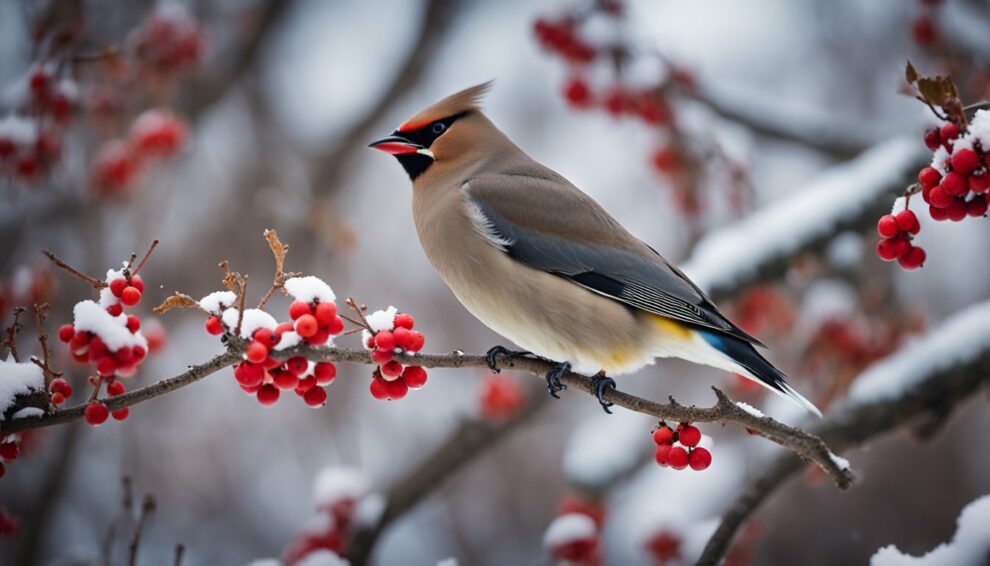Waxwings are quite the winter spectacle with their masked faces and sleek, colorful plumage.
As winter takes hold and most birds hunker down, these social songbirds embark on a quest for berries, their favored winter fare.
Unlike many birds that migrate to warmer climates, waxwings travel in search of fruit-laden trees.
The sight of a flock descending onto berry bushes can be thrilling, as they flutter and feast, brightening up the bare branches with their presence.

The berry obsession of waxwings is more than a gourmet preference; it’s a survival strategy.
With insects scarce in the cold season, these birds turn to sugary berries to fuel their energetic lives.
Yet, their diet is so specialized that it drives their movement across the landscape.
When local berry supplies dwindle, waxwings take to the wing, sometimes traveling vast distances.
This nomadic lifestyle ensures they find the fruit they need to see them through the winter months.
But why berries? Well, they are packets of energy and waxwings are experts at finding and gobbling them up.
They favor berries high in sugar content, which offer a quick and abundant energy source.
Observing waxwings in action is a lesson in efficiency; they can strip a berry bush clean in no time, ensuring that every bird gets its fill before moving on.
As winter adventurers, these birds show us how life thrives in the chill, with a little help from nature’s sweet treats.
The Waxwing’s Unique Characteristics

Waxwings are not just any bird you might spot in your backyard; they have a range of features that make them stand out in the avian world.
Readers will discover the waxwing’s striking appearance, their musical nature, and the berry-centric diet that sustains them through the winter months.
Distinctive Physical Features
Waxwings possess a unique splendor that’s easy to spot, particularly due to their pronounced crest that sits atop their heads.
Their plumage is a soft blend of gray and brown with a warm, peach-colored wash over the head and face.
What truly sets them apart, though, is the distinctive black mask around their eyes, giving them a mysterious bandit-like appearance.
These handsome feathers aren’t just for show; they play a role in social communication and courtship among waxwings.
The Melodious Calls of Waxwings
Have you ever heard the soft yet keen high-pitched whistle of the waxwing?
Their calls are a symphony in the skies, ranging from trilling melodies to sharp calls that can carry over long distances.
These vocals are not just for our listening pleasure; waxwings use them to maintain flock cohesion and alert others to food sources or danger.
Dietary Habits and Berry Preference
When it comes to food, waxwings have a near one-track mind: berries.
In cold weather when insects are scarce, they scour landscapes for fruit-laden trees and shrubs.
But not just any berry will do; waxwings prefer those high in sugar content, which provide the energy required for survival in winter.
This quest for berries is not solitary; waxwings are often seen in large, sociable flocks, sharing the bounty with fellow feathered friends.
Migratory Patterns and Breeding Behavior

The Cedar Waxwing’s appetite for berries and its nomadic lifestyle are closely intertwined with its migration and breeding habits.
Learn how these agile fliers traverse great distances in search of food and how they create cozy abodes for their future offspring.
Seasonal Movements and Range
Cedar Waxwings are not your average snowbirds; they have a flexible travel itinerary that is driven by their stomachs.
During winter, they can be found across North America, from Canada to the southern United States, always on the lookout for berry-filled trees.
When summer rolls around, they prefer to settle in the northern reaches, from the United States’ northern states all the way up into Canada, where they find abundant food and ideal breeding spots.
Did you know waxwings travel in flocks that flutter from tree to tree in a mesmerizing dance, feasting as they go?
They’ve mastered the art of survival in chilly climates by following their berry buffet all the way from the freezing homes up north down to where the winter air is just a tad warmer.
Nesting and Raising Young
Once the warmer days of summer make their grand entrance, Cedar Waxwings get down to the business of family life.
They cleverly conceal their nests in trees or shrubs, using grass, twigs, and even horsehair to build a secure and comfortable home for their cherished eggs.
Imagine a mama Waxwing, safe within the nest, carefully incubating her eggs for about 12 to 16 days before her precious babies hatch.
After they make their grand entrance into the world, both parents stay remarkably busy, feeding their ravenous fledglings a diet rich in protein—yup, you guessed it—more berries!
Plus, a few insects for good measure.
After about two weeks, the young Waxwings are ready to fledge, fluttering out of the nest with bold ambition to begin their very own berry-chasing adventures.
How amazing is it that from the moment they’re born, these little guys are prepped and primed to join the great berry hunt across the continent?
The cycle of migration and breeding, driven by their love for berries, shows just how remarkable nature is in ensuring the survival and growth of every feathery Waxwing family.
Survival Tactics During Harsh Winters

As the temperature plunges, waxwings employ a set of specialized strategies for finding food and staying warm.
The focus of this section is on how these birds actively pursue fruits and berries, and how their social behavior plays a key role in their survival during the winter months.
Foraging Strategies for Cold Months
Waxwings are exceptional foragers, with a diet that shifts with the seasons.
In the winter, they seek out fruits and berries, which are not only rich in sugars for immediate energy but also offer the necessary calories for maintaining body heat.
Surprisingly, some fruits only ripen in the cold of winter, making them more available when these birds need them most.
Apple and hawthorn trees, loaded with frozen delights, become hotspots for feeding flocks.
The birds are experts at gleaning, deftly plucking individual berries from their icy perch.
The symbiotic relationship is clear: waxwings need these fruits to survive the cold months, and in return, their feasting helps with the dispersal of seeds far and wide, ensuring the propagation of the plants they rely on.
Social Interactions Within Flocks
The waxwing’s social nature comes into play beautifully during these harsh winter months.
Flocks, which can number in the hundreds, are often seen descending upon fruit-laden trees in a quiet spectacle.
The birds communicate with subtle calls, coordinating their efforts to find and consume the precious berries.
There’s a sense of camaraderie as they share the bounty among themselves.
This behavior not only helps individual waxwings to survive but also ensures the survival of the flock as a whole.
Remarkably, these shared feeding sessions can also help the waxwings conserve energy, since finding food alone in the vast wintry landscape would be a much more demanding task.
Have you ever spotted a flock in your backyard?
Their unity is not just endearing; it’s also a critical part of how they make it through the winter.
It goes to show that even in the wild, working together can increase the odds of overcoming challenges — a little lesson we might all take to heart.
Human Interactions and Conservation

Waxwings have a unique relationship with their surroundings, adapting to urban areas while also relying on preserved natural habitats.
Understanding how they interact with these environments is key to ensuring their survival.
The Waxwing and Its Urban Environment
In the quest for nutrition, waxwings don’t shy away from urban settings, often descending upon gardens brimming with bushes and fruit trees.
Their affection for berries might lead them to your backyard, where fruit-bearing trees become banquet halls for these sleek birds.
Cities unwittingly provide an array of feasting options for them, from rowan to hawthorn trees.
Have you spotted them in your garden, fluttering from branch to branch, indulging in their berry obsession?
Yet, this urban attraction is not without its dangers. Windows pose a serious threat, causing collisions that can injure or be fatal to waxwings.
They also face competition for nest sites in cities, where buildings and renovations can disrupt their nesting places.
Waxwings flourish when their urban environments safely cater to their foraging and nesting needs.
Protecting the Waxwing’s Natural Habitat
The allure of the wild is never too far from a waxwing’s heart.
They depend on natural habitats where conservation efforts ensure the availability of berry-laden bushes and natural spaces for healthy breeding.
Groups like NatureServe focus on preserving these environments, recognizing the importance of biodiversity.
Did you know that by nurturing native fruit trees in natural reserves or parks, we help waxwings thrive?
Protecting these habitats is crucial as waxwings don’t just bring beauty to our lives; they play a role in spreading seeds and supporting the ecosystem.
Through conservation measures, we safeguard the delicate balance of nature, ensuring that waxwings continue to grace our winters with their charismatic presence and vivid splashes of color as they migrate and forage for their beloved berries.
Have you ever wondered how you might contribute to these conservation efforts in your own community?
Frequently Asked Questions
Berries are critical for waxwing survival during the cold months.
This section answers some of the most intriguing questions about these birds and their berry-based diets.
What clever tricks do waxwings employ to ensure they have enough berries to last through the cold winter months?
Waxwings are resourceful foragers, often forming large flocks to search for fruiting trees and shrubs.
When food becomes scarce, they cover vast distances to locate new berry supplies. They are also known to visit platform bird feeders occasionally.
How do waxwings help plants they feast on, and what’s the secret behind this sweet partnership?
While munching on the berries, waxwings play a crucial role in seed dispersal.
The birds consume the fruit and later deposit the seeds elsewhere through their droppings, assisting in the propagation of these berry-producing plants.
Can you tell me why waxwings sometimes seem a bit tipsy around berry bushes in the wintertime?
Sometimes, waxwings may appear intoxicated due to fermenting berries.
As the fruit overripens or freezes and thaws, it can naturally ferment, turning sugars into alcohol.
When the birds eat these fermented fruits, they may exhibit tipsy behaviors.
Why are waxwings so attracted to berries, and what does this mean for their diet compared to other birds?
Waxwings specialize in eating berries because they provide essential nutrients and a high-energy food source.
Unlike many birds that switch to insects or seeds in winter, waxwings continue to seek out sugary fruits, making them a critical part of their diet all year round.
How do waxwings survive the winter when their favorite berry-filled bushes are covered in snow?
Waxwings have adapted to their berry-rich diet by developing a nomadic lifestyle.
When snow covers their food sources, waxwings will travel great distances to find uncovered berry bushes or fruit-laden trees.
What’s the impact of berry availability on waxwing migration patterns during the winter season?
Berry availability is a strong driver of waxwing migration patterns.
Rather than following a strict migratory path, waxwings wander nomadically during the winter months, moving to locations rich in berry resources, demonstrating their highly adaptive nature.









